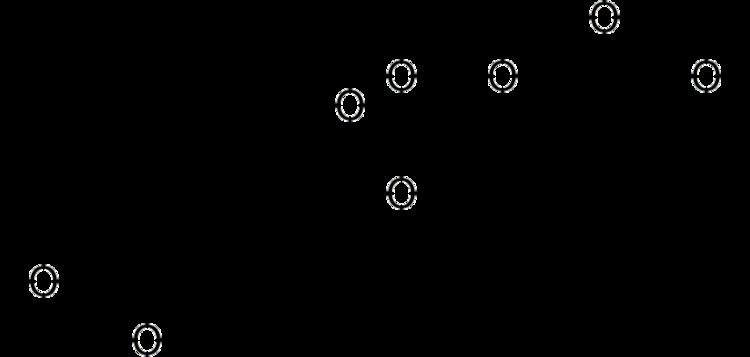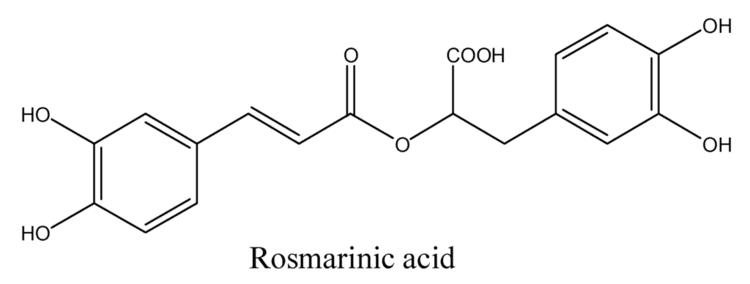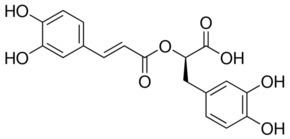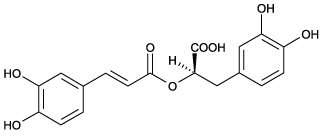Formula C18H16O8 | Appearance Red-orange powder | |
 | ||
Rosmarinic acid is a chemical compound found in a variety of plants. It has antioxidant properties.
Contents
History

Rosmarinic acid was first isolated and characterized in 1958 by the Italian chemists M. L. Scarpatti and G. Oriente from rosemary (Rosmarinus officinalis).
Chemistry
Chemically, rosmarinic acid is a caffeic acid ester of salvianic acid A (3,4-dihydroxyphenyllactic acid).
Natural occurrences

Rosmarinic acid accumulation is shown in hornworts, in the fern family Blechnaceae and in species of several orders of mono- and dicotyledonous angiosperms.

It is found most notably in many Lamiaceae (dicotyledons in the order Lamiales), especially in the subfamily Nepetoideae. It is found in species used commonly as culinary herbs such as Ocimum basilicum (basil), Ocimum tenuiflorum (holy basil), Melissa officinalis (lemon balm), Rosmarinus officinalis (rosemary), Origanum majorana (marjoram), Salvia officinalis (sage), thyme and peppermint or in plants with medicinal properties such as common self-heal (Prunella vulgaris) or species in the genus Stachys.
It is also found in other Lamiales such as Heliotropium foertherianum, a plant in the family Boraginaceae.

It is also found in plants in the family Marantaceae (monocotyledons in the order Zingiberales) such as species in the genera Maranta (Maranta leuconeura, Maranta depressa) and Thalia (Thalia geniculata).
Rosmarinic acid and the derivative rosmarinic acid 3′-O-β-D-glucoside can be found in Anthoceros agrestis, a hornwort (Anthocerotophyta).
Biosynthesis

The biosyntheses of rosmarinic acid uses 4-coumaroyl-CoA from the general phenylpropanoid pathway as hydroxycinnamoyl donor. The hydroxycinnamoyl acceptor substrate comes from the shikimate pathway: shikimic acid, quinic acid and 3,4-dihydroxyphenyllactic acid derived from L-tyrosine. Thus, chemically, rosmarinic acid is an ester of caffeic acid with 3,4-dihydroxyphenyllactic acid, but biologically, it is formed from 4-coumaroyl-4'-hydroxyphenyllactate. Rosmarinate synthase is an enzyme that uses caffeoyl-CoA and 3,4-dihydroxyphenyllactic acid to produce CoA and rosmarinate. Hydroxyphenylpyruvate reductase is also an enzyme involved in this biosynthesis.
The enzymes involved in the biosynthesis pathway probably evolved from those used in the formation of chlorogenic and caffeoylshikimic acids.
In plants, rosmarinic acid is supposed to act as a preformed constitutively accumulated defense compound.
Biochemical activities
Rosmarinic acid is a potential anxiolytic as it acts as a GABA transaminase inhibitor, more specifically on 4-aminobutyrate transaminase. Rosmarinic acid also inhibits the expression of indoleamine 2,3-dioxygenase via its cyclooxygenase-inhibiting properties.
Senescent leaves of Heliotropium foertherianum (Boraginaceae) also known as octopus bush, a plant used in many Pacific islands as a traditional medicine to treat ciguatera fish poisoning, contain rosmarinic acid and derivatives. Rosmarinic acid may remove the ciguatoxins from their sites of action.
The use of rosmarinic acid is effective in a mouse model of Japanese encephalitis.
